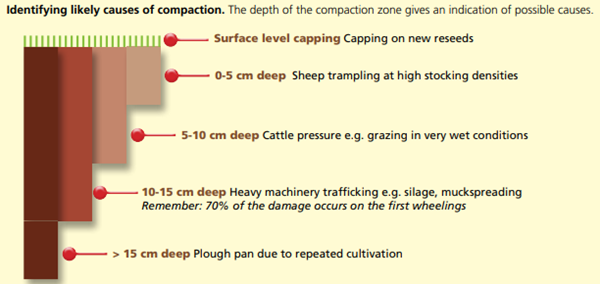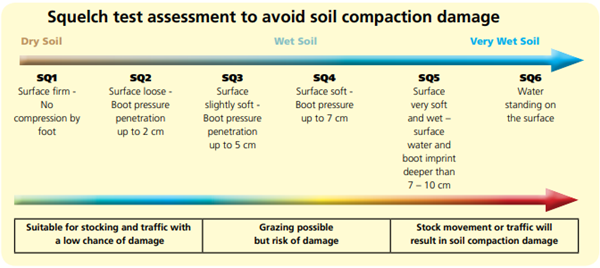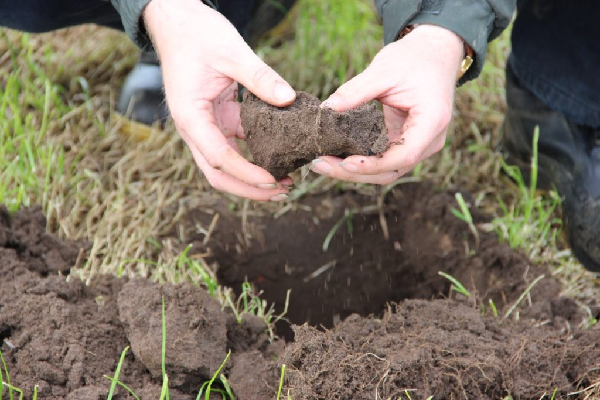Tackling Soil Compaction to Reduce Fertiliser Costs
1 December 2021Dairy farmers across Scotland often rely on fertiliser to ensure that they grow enough grass to meet the needs of their livestock. However, fertiliser prices have soared recently, which will undoubtedly put pressure on farm incomes. So how do we grow more grass with less fertiliser?
Compaction in soils is a well-known problem for dairy farmers. Research on the effect of varying levels of compaction on grass yields over three years found that yields were reduced by up to 19.0% for trampling and 37.7% for tractor related compaction (Hargreaves, et al., 2019). This was due to the compacted soil being less able to uptake N, as well as exhibiting decreased water infiltration.
Indicators of soil compaction
So how do we know if our soil is healthy? Visually, you will likely be able to identify areas of the field that could potentially show indications of poor soil health and compaction (see diagram below). These can include but are not limited to;
- Area of the field with low yield
- Surface water present after heavy rainfall
- The grass in that area is showing some discolouration (yellowing of leaves)
- Higher prevalence of weed species within the sward
If any of these signs are present the next step is to conduct a Visual Evaluation of Soil Structure (VESS). The Farm Advisory Service Website has a very useful video where Dr Bill Crooks talks us through how to complete a VESS, available at: https://www.fas.scot/publication/a-guide-to-the-visual-evaluation-of-soil-structure-vess/
It is worth noting that it is difficult to assess soil structure if the soil is too wet or too dry.
Causes of compaction (SRUC, 2016)
Correcting soil compaction
Once the VESS has been completed and soil compaction has been identified, the next stage is to consider your options for correcting the compaction. There are three main tools available to correct compaction, outlined in the table below.
Mechanical tools available to correct compaction
| Compaction area | Tool | Guide Cost (£/ha) |
|---|---|---|
| 0 to 15cm depth | Aerators | 23.06 |
| 15 to 35cm depth | Sward lifters | 62.10 |
| 35 to 50cm depth | Subsoilers | 67.17 |
The plough also decreases compaction in the topsoil. However, a plough and reseed is quite a costly method to correct compaction in the topsoil and it does not correct deeper compaction. Timing is critical to optimise subsoiling. Subsoiling soil that is too wet can make water infiltration poorer. The optimum conditions are when the soil is dry.
Despite mechanical tools being available to correct soil compaction, it is important to remember that prevention is better than the cure. Therefore, assessing the suitability of your fields for traffic/stocking can help you maintain good soil condition. This can be achieved by conducting a simple ‘squelch test’ as shown below.
The squelch test (SRUC, 2016)
Scenario
A 10ha field with compaction costs £62.10/ha to sward lift and correct, whereas a case study by SRUC (2016) found that compaction costs up to £158/ha in lost production, when there is a 14% drop in yield, but as more recent studies have shown the yield loss can be much greater. Therefore, on a 10ha field you could be £959 better off due to correcting the soil compaction.
Conclusion
It is clear that the current price of fertiliser presents a challenge to the dairy sector. It is important to maximise grass production by ensuring that the soil is healthy and free from compaction to help increase yields with less fertiliser and increase the effectiveness of any nutrients that are applied.
Further Information
Hargreaves, P. R. et al., 2019. Soil compaction effects on grassland silage yields and soil structure under different levels of compaction over three years. [Online]
Available at: https://www.sciencedirect.com/science/article/pii/S1161030119300541#sec0055
SRUC, 2016. Valuing Your Soils – Practical Guide for Scottish Farmers. [Online]
Available at: https://www.fas.scot/downloads/valuing-soils-practical-guidance-scottish-farmers/
https://www.fas.scot/crops-soils/soils/
Farm Management Handbook 2021/22 available at: https://www.fas.scot/publication/fmh2022/
Sign up to the FAS newsletter
Receive updates on news, events and publications from Scotland’s Farm Advisory Service



